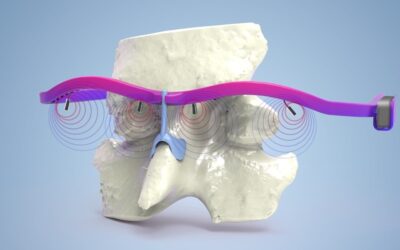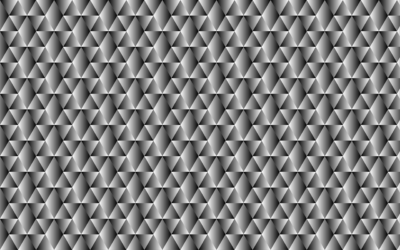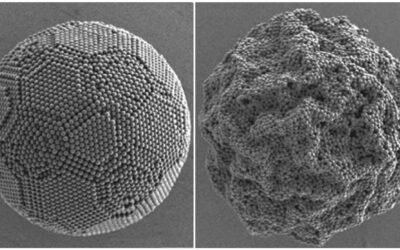Scientists have discovered a new method to monitor the long-term behavior of skyrmions — tiny, swirling magnetic structures formed by the natural magnetism of atoms. Atomic magnetic moments, which arise from the movement and spin of electrons within each atom, give skyrmions their unique properties. These innovative structures hold promise as building blocks for ultra-efficient computers.
“Skyrmions are nanometer- to micrometer-sized localized whirls of magnetization that behave like particles,” explained the head of the theory group, Peter Virnau of Johannes Gutenberg University Mainz in Germany. “For instance, they perform thermal diffusion similar to the Brownian motion of molecular systems and repel each other.”
Unlike conventional computers based on transistors — the fundamental building blocks of computer chips that switch electric current on and off to process information — skyrmion-based computers, in principle, require far less energy to operate. Transistors are becoming harder to shrink and increasingly power-hungry, pushing current computing technology toward its limits. Skyrmions, in contrast, could offer a more energy-efficient alternative.
“What sets them apart is that they can be moved with ultra-low electrical currents, that their size can be tuned using magnetic fields, and that they can be created and annihilated, for instance, using currents or magnetic field pulses,” said Mathias Kläui, head of the experimental group.
By improving how skyrmions are modeled over time, Virnau, Kläui and their research groups hope to help bring these futuristic devices closer to reality.
“The ability to perform quantitative simulations on experimentally relevant large-length and time scales is incredibly valuable in designing skyrmion-based devices, such as non-conventional computers, as we can quickly optimize parameters using parallel simulations,” Virnau said.
Rethinking computing with skyrmions
One exciting way skyrmions could be used in future computing is by harnessing their natural, random motion to perform calculations. This idea, known as Brownian computing, takes advantage of the fact that skyrmions are constantly jostled around by thermal fluctuations — tiny, unpredictable movements caused by the heat-driven vibrations of atoms in the material they exist in. Instead of working against this randomness, as traditional computers do, scientists have developed methods to use it as a computational resource.
Brownian computing is particularly well-suited for solving problems where randomness is an advantage rather than an obstacle. This includes optimization problems, where a system must search for the best possible solution among many possibilities, as well as probabilistic simulations used in fields such as finance, biology, and artificial intelligence. In these cases, the skyrmions’ random movement naturally explores different possibilities without requiring direct control over each step of the process.
Because this method does not require continuous power to manipulate the skyrmions directly, it dramatically reduces energy consumption compared to conventional computing methods, making it an attractive alternative for future low-power computation.
Challenges in modeling skyrmion behavior
Despite their potential, designing skyrmion-based devices presents significant challenges.
Part of the problem lies in the difficulty in modeling their behavior to better understand them in order to apply them to real-world applications.
This is because skyrmions involve thousands to millions of atoms, each interacting with its neighbors through complex magnetic forces. As these interactions collectively determine how a skyrmion evolves over time, tracking them with high precision quickly becomes computationally overwhelming. Current modeling techniques struggle to accurately capture their dynamics over the extended periods necessary for practical device operation.
“Conventional atomistic or micromagnetic simulations that explicitly simulate the skyrmions’ internal structure are usually too computationally expensive to make predictions on large length- and time-scales relevant experiments and devices,” Virnau explained.
But Virnau and his team have a clever work around. “A solution is to simulate an entire skyrmion as a particle, similar to a molecular dynamics simulation in biophysics, and describe its internal structure using effective parameters,” he said.
Instead of representing skyrmions as collections of individual electrons, Virnau and his colleagues modeled them as single particles, measuring key properties of a skyrmion as a whole, which allowed them to simulate its behavior more efficiently.
“We can now make quantitative predictions of skyrmion dynamics,” said theoretical physicist Maarten Brems, who developed the method as a member of Virnau’s research group.
To gather the key data for their simulation, the researchers used advanced microscopy techniques to observe skyrmions in action. They worked with a specially designed material made of boron, cobalt, iron, magnesium, oxygen, and tantalum, chosen for its ability to host and control skyrmions using an electric current.
By measuring how skyrmions move in response to temperature and the force they experienced from an applied electric current, the team was able to simulate their motion over relevant timescales, ranging from seconds to hours—which was previously impossible with more detailed models.
“Interestingly, the particle-based simulations are so efficient that for most systems, simulations are comparable in speed to the experiments,” said Brems. “This is a rare thing in condensed matter, as simulations are usually orders of magnitude slower.”
Future directions
This innovative approach opens the door to a wide range of follow-up studies. Researchers can now explore how skyrmion behavior depends on factors like material structure, temperature, and applied magnetic fields. The method is also broadly applicable to other systems that can be modeled using particle-based simulations.
“With these advancements, we really want to push forward the development of novel, alternative energy-saving computing architectures, which are the focus of Johannes Gutenberg University’s top-level research area, ‘TopDyn — Dynamics and Topology,’ amongst others,” Kläui said.
Beyond practical applications, skyrmions also offer opportunities to study fundamental physics. Their two-dimensional nature makes them ideal for exploring phenomena like phase transitions, which could differ significantly from those observed in three-dimensional systems.
“Skyrmions are incredibly interesting for researching fundamental physics, as they can be created in materials that are very thin compared to the skyrmions’ size, making them almost ideal two-dimensional particles,” Virnau said. “In two dimensions, phenomena such as the solid-liquid transitions can fundamentally change due to the introduction of an intermediate phase. We look forward to exploring such systems further in collaboration between simulation and experiment.”
Reference: Maarten A. Brems et al, Realizing Quantitative Quasiparticle Modeling of Skyrmion Dynamics in Arbitrary Potentials, Physical Review Letters (2025), DOI: 10.1103/PhysRevLett.134.046701
Feature image credit: 00rwullie on Pixabay

















